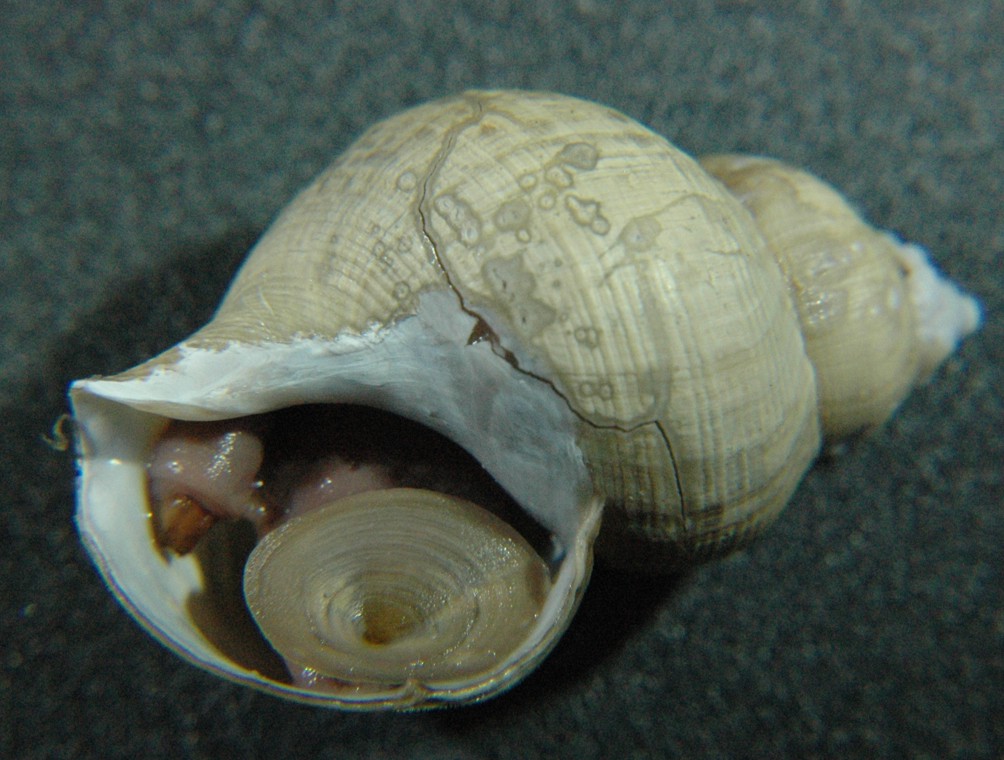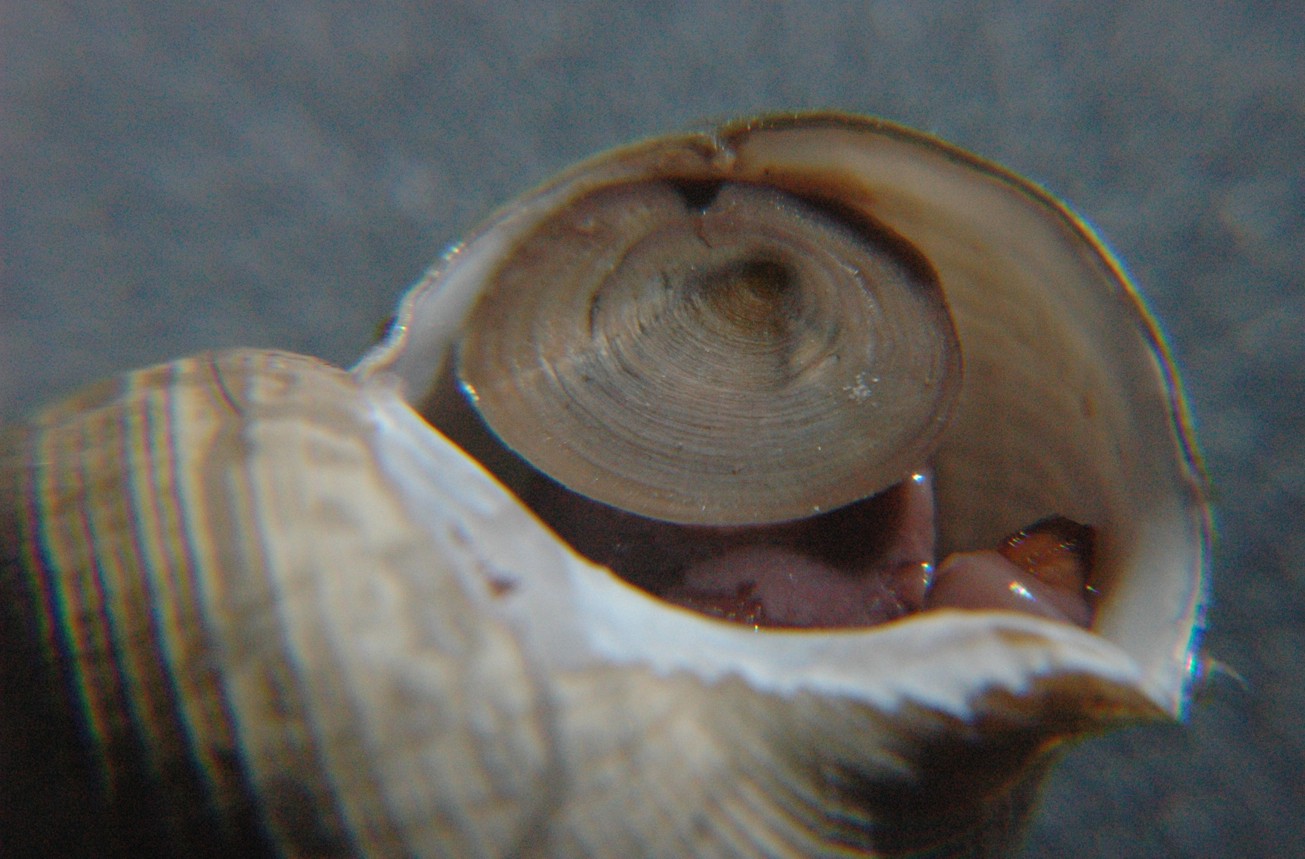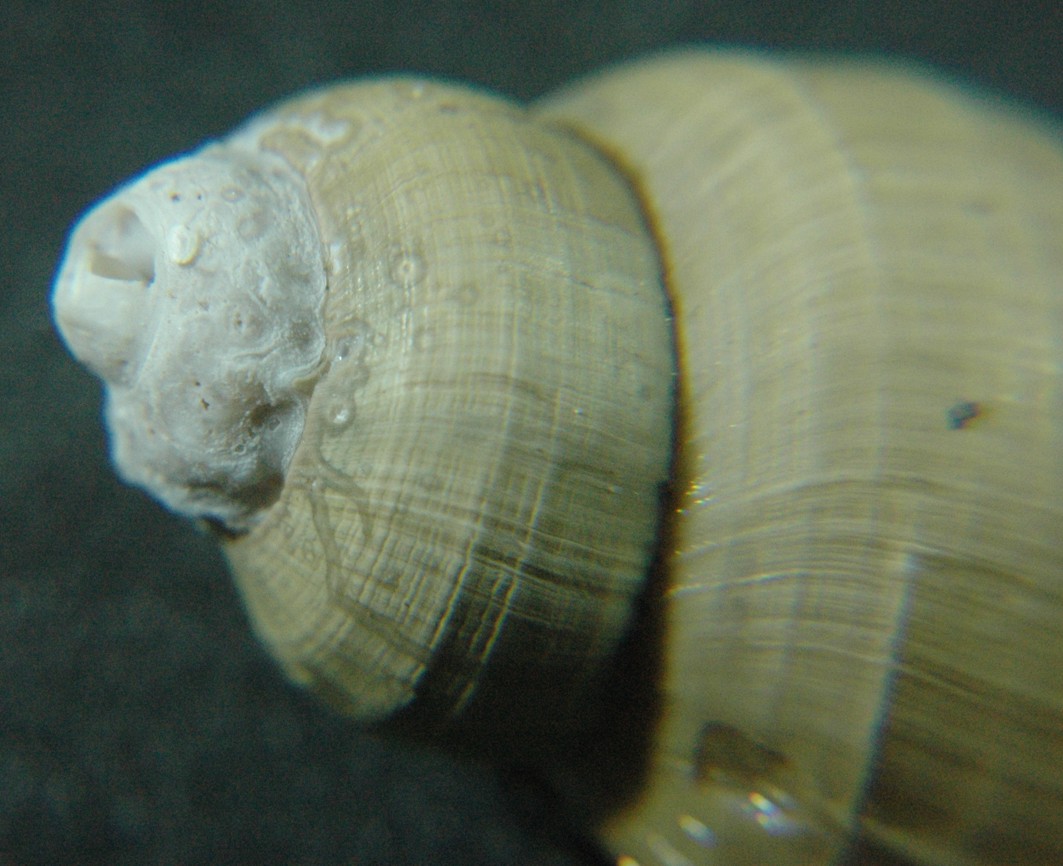Description: Whelks of family Buccinidae (true whelks) tend to be moderate to large in size, with smooth or sculptured whorls which often have a distinct shoulder. The aperture is large and a siphonal canal and horny operculum are present. They have two eyes at the base of tentacles, and a well-developed sense of smell. Usually predatory or scavengers. Genus Buccinum consists of medium-sized snails with elongated, ovate shells. The spire is pointed. The aperture is oval or oblong with a deep anterior notch. The operculum is thin and has concentric striations. The eyes are very small. As a member of subgenus Viridibuccinum (Golikov and Sirenko, 1988), this snail has a relatively thin shell (deep-living whelks tend to have thinner shells than shallow ones). The whorls are convex, have angulated or rounded shoulders, and are separated by a deep suture. The main sculpture consists of numerous narrow, spiral cords which are of similar size and slightly wavy. B. thermophilum has an extremely thin, ovate-conic shell with regular, roundly inflated whorls and a very short, broad siphonal canal (photo). The protoconch is usually eroded (photo). The teloconch consists of up to 5 rounded or weakly shouldered whorls. The sutures connect well anterior to the largest portion of the previous whorl. Spiral cords closely spaced and may be of variable sizes above shoulder of each whorl but more widely spaced below and may be interspersed with thin, spiral threads (photo). Axial sculpture consists only of fine, sometimes irregular, weakly recurved growth lines (photo). The aperture is large, ovate (nearly elliptical), about half the shell length (photo). The outer lip is thin and evenly rounded (photo). The columella is weakly concave (photo). The siphonal canal is very short, broad, and open, with a sharp siphonal fold (photo). The operculum is about 2/3 the length of the aperture, ovate and horny with concentric rings (photo). The periostracum is very thin and olive brown, is usually missing from some parts of the shell, and usually cracks upon drying (photo). Shell color white, yellow, beige, or gold. Shell height to 3.8 cm.
How to Distinguish from Similar Species: This is the only whelk found so far at the Juan de Fuca ridge vents, although the widespread B. viridum is found at Explorer Ridge 200 km to the north. Most similar in morphology to Buccinum elatior, the type species for subgenus Viridobuccinum.
Geographical Range: At hydrothermal vents in the Endeavor Vent Field, on the Juan de Fuca Ridge. Type locality 'Smoke and Mirrors' site, 47 deg 56.89 minutes N, 129 deg 05.91 minutes W, 2194 m
Depth Range: Around 2000 m
Habitat: Various substrates at hydrothermal vents.
Biology/Natural History:
(abstracted
from Martell
et al., 2002): Found around hydrothermal vents and
may climb
sulphide mounds but avoids the hot vent waters. The
color of
the snails varied at different vents, suggesting limited
dispersal.
Most often they are seen waving their incurrent
siphons above the shell. Stomach contents included
parts of hydrothermal
vent vestimentiferans, pycnogonid legs, polychaete setae,
and flesh. Likely prey include the thin-shelled hydrothermal
vent
limpet Lepetodrilus
fucensis
(Voight
and Sigwart, 2007). Predators include the majid
crab Macroregonia
macrochira, which cracks the shell or peels back the aperture
to get at the snail's flesh Scars on the snail's shell are
probably
from predation. May aggregate at times. Lay eggs in
attached
masses of lens-shaped capsules, each of which contains 200-450
eggs.
Egg size is about 275 microns, capsule diameter is about 5-6 mm, and
egg
mass may be up to 6.5 cm. Buccinid whelks usually hatch from
eggs
as juveniles and so have limited dispersal capability.
Deep-sea Buccinids
can survive for up to a year without food.
| Return to: | |||
| Main Page | Alphabetic Index | Systematic Index | Glossary |
References:
Dichotomous Keys:General References:
Scientific Articles:
Harasewych, M.G. and Yuri I. Kantor, 2002. Buccinum thermophilum (Gastropoda: Neogastropoda: Buccinidae), a new species from the Endeavor vent field of the Juan de Fuca Ridge. Journal of Molluscan Studies 68:1 pp. 39-44
Martell, Kathryn A., Verena Tunnicliffe, and Ian R. Macdonald, 2002. Biological features of a buccinid whelk (Gastropoda: Neogastropoda) at the Endeavor ventfields of Juan de Fuca Ridge, Northeast Pacific. Journal of Molluscan Studies 68:1 pp 45-53
Voight, Janet R. and Julia D. Sigwart, 2007. Scarred limpets at hydrothermal vents: evidence of predation by deep-sea whelks. Marine Biology 152: pp 129-133
Web sites:
General Notes and
Observations: Locations,
abundances, unusual behaviors:
My thanks to Kirt Onthank for providing me the preserved specimens photographed on this page.

Notice the thin, yellowish, easily-cracked periostracum. The aperture is approximately half the length of the shell.
This closeup of the aperture
on a preserved sample shows the horny operculum
and the concave columella.
The tip of the incurrent
siphon is visible near the broad siphonal
canal at the lower right.
The protoconch
(left) is mostly worn away. Note the spiral
ridges (cords) and the thin axial
growth lines on the teleconch
whorls
(middle
and right). The whorls
are rounded or have a slight shoulder.
Authors and Editors of Page:
Dave Cowles (2014): Created original page
CSS coding for page developed by Jonathan Cowles (2007)
Salish Sea Invertebrates web site provided courtesy of Walla
Walla University

